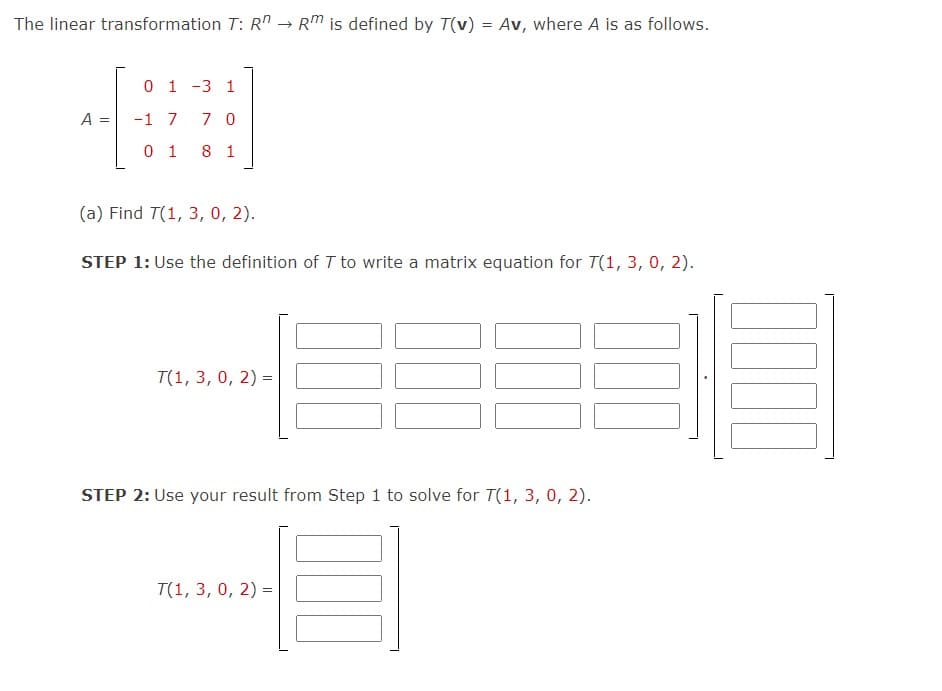The linear transformation T: R → RM is defined by T(v) = Av, where A is as follows. A = 0 1-3 1 -1 7 70 0 1 8 1 (a) Find T(1, 3, 0, 2). STEP 1: Use the definition of T to write a matrix equation for T(1, 3, 0, 2). T(1, 3, 0, 2) = 100 STEP 2: Use your result from Step 1 to solve for T(1, 3, 0, 2). T(1, 3, 0, 2) = 000 000 100
The linear transformation T: R → RM is defined by T(v) = Av, where A is as follows. A = 0 1-3 1 -1 7 70 0 1 8 1 (a) Find T(1, 3, 0, 2). STEP 1: Use the definition of T to write a matrix equation for T(1, 3, 0, 2). T(1, 3, 0, 2) = 100 STEP 2: Use your result from Step 1 to solve for T(1, 3, 0, 2). T(1, 3, 0, 2) = 000 000 100
Elementary Linear Algebra (MindTap Course List)
8th Edition
ISBN:9781305658004
Author:Ron Larson
Publisher:Ron Larson
Chapter7: Eigenvalues And Eigenvectors
Section7.CM: Cumulative Review
Problem 12CM
Related questions
Question

Transcribed Image Text:The linear transformation T: R → RM is defined by T(v) = Av, where A is as follows.
A =
0 1
-3 1
-1 7 7 0
0 1 8 1
(a) Find T(1, 3, 0, 2).
STEP 1: Use the definition of T to write a matrix equation for T(1, 3, 0, 2).
T(1, 3, 0, 2) =
STEP 2: Use your result from Step 1 to solve for T(1, 3, 0, 2).
T(1, 3, 0, 2) =
0000

Transcribed Image Text:(b) Find the preimage of (0, 0, 0).
STEP 1: The preimage of (0, 0, 0) is determined by solving the following equation.
T(w, x, y, z) =
W =
X =
y =
0 1 -3 1
-1 7 7 0
0
1
8 1
z = t
W
Let t be any real number. Set z = t and solve for w, x, and y in terms of t.
X
Z
0
STEP 2: Use your result from Step 1 to find the preimage of (0, 0, 0). (Enter each vector as a comma-separated list of its components.)
The preimage is given by the set of vectors {(
): t is any real number}.
Expert Solution
This question has been solved!
Explore an expertly crafted, step-by-step solution for a thorough understanding of key concepts.
Step by step
Solved in 3 steps with 3 images

Recommended textbooks for you

Elementary Linear Algebra (MindTap Course List)
Algebra
ISBN:
9781305658004
Author:
Ron Larson
Publisher:
Cengage Learning

Linear Algebra: A Modern Introduction
Algebra
ISBN:
9781285463247
Author:
David Poole
Publisher:
Cengage Learning

Elementary Linear Algebra (MindTap Course List)
Algebra
ISBN:
9781305658004
Author:
Ron Larson
Publisher:
Cengage Learning

Linear Algebra: A Modern Introduction
Algebra
ISBN:
9781285463247
Author:
David Poole
Publisher:
Cengage Learning